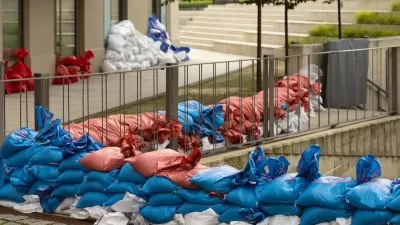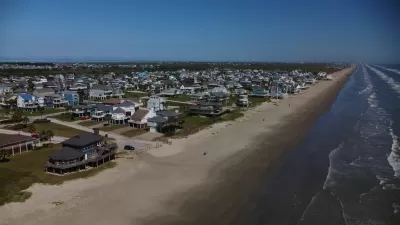New climate and flood models are needed to understand growing flood risks.

A ‘new normal’ of flooding and extreme weather events is prompting cities around the country to reevaluate their water infrastructure and flood risk models, writes Carl Smith in Governing. Smith notes that “floods are the most common and widespread weather-related disasters. Estimates of their annual cost range from $180 billion to $496 billion a year.”
Daniel Swain, a University of California, Los Angeles climate scientist, says “Virtually all of the infrastructure that we have built was built for a climate that no longer exists.” To address this, a new report from the US Water Alliance, Water Rising: Equitable Approaches to Urban Flooding, identifies priority areas for resilience and equity planning and encourages cities to assess their own local challenges and infrastructure.
In Hampton, Virginia, the Hampton Roads Sanitation District (HRSD) produced a report that highlights risks and resources in the region, offering local officials “an opportunity to look at exposure to climate hazards among the more than 150 facilities in the HRSD system and possible floodwater levels now and in the future.”
According to Swain, “Localities must gather and heed this kind of data as they plan for infrastructure improvements.” Mami Hara, CEO of the US Water Alliance, suggests a more regional approach to water infrastructure, such as a “regional resilience entity that brings together water and climate issues.”
FULL STORY: Planning for a Daunting New Normal of Flood Risk

Alabama: Trump Terminates Settlements for Black Communities Harmed By Raw Sewage
Trump deemed the landmark civil rights agreement “illegal DEI and environmental justice policy.”

Planetizen Federal Action Tracker
A weekly monitor of how Trump’s orders and actions are impacting planners and planning in America.

Why Should We Subsidize Public Transportation?
Many public transit agencies face financial stress due to rising costs, declining fare revenue, and declining subsidies. Transit advocates must provide a strong business case for increasing public transit funding.

Understanding Road Diets
An explainer from Momentum highlights the advantages of reducing vehicle lanes in favor of more bike, transit, and pedestrian infrastructure.

New California Law Regulates Warehouse Pollution
A new law tightens building and emissions regulations for large distribution warehouses to mitigate air pollution and traffic in surrounding communities.

Phoenix Announces Opening Date for Light Rail Extension
The South Central extension will connect South Phoenix to downtown and other major hubs starting on June 7.
Urban Design for Planners 1: Software Tools
This six-course series explores essential urban design concepts using open source software and equips planners with the tools they need to participate fully in the urban design process.
Planning for Universal Design
Learn the tools for implementing Universal Design in planning regulations.
Caltrans
Smith Gee Studio
Institute for Housing and Urban Development Studies (IHS)
City of Grandview
Harvard GSD Executive Education
Toledo-Lucas County Plan Commissions
Salt Lake City
NYU Wagner Graduate School of Public Service





























